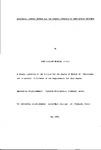ELECTRICAL CONTACT BOUNCE AND THE CONTROL DYNAMICS OF SNAP-ACTION SWITCHES
| dc.contributor.author | McBRIDE, JOHN WILLIAM | |
| dc.contributor.other | School of Engineering, Computing and Mathematics | en_US |
| dc.date.accessioned | 2013-10-30T13:12:56Z | |
| dc.date.available | 2013-10-30T13:12:56Z | |
| dc.date.issued | 1986 | |
| dc.identifier | NOT AVAILABLE | en_US |
| dc.identifier.uri | http://hdl.handle.net/10026.1/2477 | |
| dc.description.abstract |
Experimental and theoretical studies are made of a typical snap-action rocker switch, to establish the wear mechanisms in the pivoting contact. The rocker switch, used extensively in consumer goods, operates in the medium duty current range, (1 - 30 Amps). Highspeed photographic studies have shown that the main cause of wear is arcing, occurring during separation and bounce at the pivot contacts. To reduce the bounce a computer-based mathematical model of the system dynamics is developed and optimised; this results in recommended design changes. These changes are tested under full current endurance conditions, and show significant improvements in wear. The model of the switch dynamics relates the mathematics of motion to the bounce occuring at the pivot contact, without the influence of current. To show the effect of current and arcing, an automatic test system is developed for the controlled testing of electrical contacts. The system has the ability to evaluate arc energy, bounce times, and contact resistance. The results presented detail the influence of d.c current on contact bounce time, and identify the importance of the subsequent bounce time; which is defined for a single make operation, as the total duration of the bounces occurring after the first bounce. To compare the erosion profiles of the switch and test system, the system is operated under full load current endurance conditions, to evaluate wear. This comparison shows that the wear in the real switch contacts is greater, as result of the additional contact movement of slip and rolling. | en_US |
| dc.description.sponsorship | Arrow-Hart (Europe) Ltd, Plymouth, Devon | en_US |
| dc.language.iso | en | en_US |
| dc.publisher | University of Plymouth | en_US |
| dc.title | ELECTRICAL CONTACT BOUNCE AND THE CONTROL DYNAMICS OF SNAP-ACTION SWITCHES | en_US |
| dc.type | Thesis | |
| plymouth.version | Full version | en_US |
| dc.identifier.doi | http://dx.doi.org/10.24382/4546 | |
| dc.identifier.doi | http://dx.doi.org/10.24382/4546 |
Files in this item
This item appears in the following Collection(s)
-
01 Research Theses Main Collection
Research Theses Main


